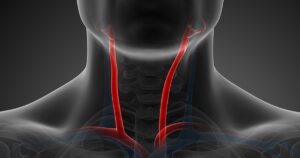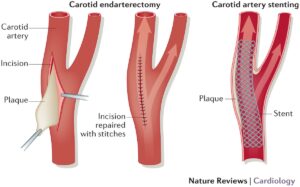
Carotid artery blockage is a serious vascular disease that causes reduced oxygenated blood flow to the brain. Although it may not show symptoms in early stages, it can lead to life-threatening risks such as stroke in advanced cases. In this article, you can find the causes, symptoms, and current treatment methods for carotid artery blockage.
The carotid artery, medically known as the carotid artery, is one of the most important arteries that carries oxygenated blood to the brain, originating from the aorta. Atherosclerosis can develop over time in one or both of these arteries located on either side of the neck. The accumulation of cholesterol and calcium deposits on the vessel wall narrows the vessel diameter and reduces blood flow. This condition is called carotid artery blockage.
As the narrowing progresses, insufficient oxygenated blood reaches the brain. As a result, transient ischemic attacks (TIA) or more serious conditions such as stroke can occur. Additionally, the rupture of plaques in the vessel wall and blocking brain vessels can also cause stroke.
Who Is Affected? What Are the Risk Factors?
Carotid artery blockage is usually seen in individuals over 50 years of age. While it is more common in men, it is also an important health problem in women. The most important risk factors are:
- Smoking
- High blood pressure (hypertension)
- Diabetes
- High cholesterol levels
- Obesity
- Sedentary lifestyle
- Family history of vascular diseases
An important point to remember is that atherosclerosis is a systemic disease. This means it can affect not only the carotid artery but also the heart vessels (coronary arteries) and leg vessels (peripheral arteries).
What Are the Symptoms of Carotid Artery Blockage?
The disease usually progresses insidiously and may not show any symptoms initially. However, some people may experience the following symptoms:
- Dizziness and loss of balance
- Temporary vision loss or blurred vision
- Numbness or weakness on one side of the body
- Speech disorder, inability to pronounce words
- Facial asymmetry
- Temporary loss of consciousness
In some cases, the disease may manifest itself directly with a stroke. Therefore, regular check-ups in individuals with risk factors are vital.
How is Carotid Artery Blockage Diagnosed?
Early diagnosis is crucial for preventing permanent neurological damage such as stroke. The methods used for diagnosis are:
1. Physical Examination
Hearing a murmur (sound created by blood passing through a narrow vessel) during stethoscope examination of the neck area is the first warning sign.
2. Doppler Ultrasonography
It is a non-invasive and quick method used to evaluate blood flow in the carotid arteries. It provides important information about the degree of vessel narrowing.
3. Angiography
It is preferred when further examination is needed. CT angiography or MR angiography are imaging methods performed by administering contrast material to the vessel. Classical digital angiography may also be preferred in some cases.

What are the Treatment Methods?
The treatment approach is determined based on the severity of the narrowing, the patient’s general health condition, and the neurological events experienced. There are 3 main treatment methods applied:
1. Medication Treatment
Drug therapy is primarily applied in mild or moderate narrowing.
- Blood pressure control
- Blood sugar regulation
- Cholesterol-lowering drugs (statins)
- Blood thinners (aspirin or clopidogrel)
These treatments aim to prevent the progression of vascular blockage and reduce the risk of stroke.
2. Stent Application
Carotid stenting may be preferred in patients with advanced narrowing but not suitable for surgery. A stent is placed in the narrowed area by entering through the groin vessel, ensuring the vessel remains open.
3. Surgical Intervention (Carotid Endarterectomy)
Surgical treatment is recommended in symptomatic patients with 50% or more vessel narrowing, especially in cases where the patient has previously experienced a transient ischemic attack or stroke. In this operation, plaques in the vessel are surgically cleaned, and blood flow is restored. It is generally a successful and permanent method.
Is It Possible to Prevent Stroke?
Yes. If carotid artery blockage is detected in time and treated appropriately, the risk of stroke can be significantly reduced. It is recommended that individuals in high-risk groups be screened with Doppler ultrasonography at regular intervals.
Additionally:
- Quit smoking
- Maintain a healthy and balanced diet
- Regular exercise should be performed
- Hypertension and diabetes should be kept under control
These lifestyle changes both slow the progression of existing vascular stenoses and reduce the risk of new blockages forming.
Carotid artery blockage is a serious vascular disease that threatens blood flow to the brain. Due to its silent progression, regular check-ups are of great importance for individuals at risk. With early diagnosis and appropriate treatment, the risk of stroke can be largely prevented. If any dizziness, speech disorder, or vision loss is experienced, medical attention should be sought without delay.



